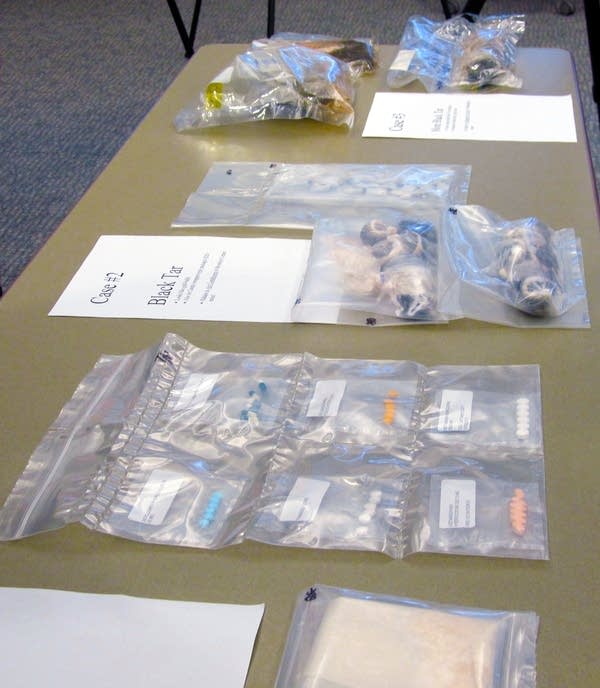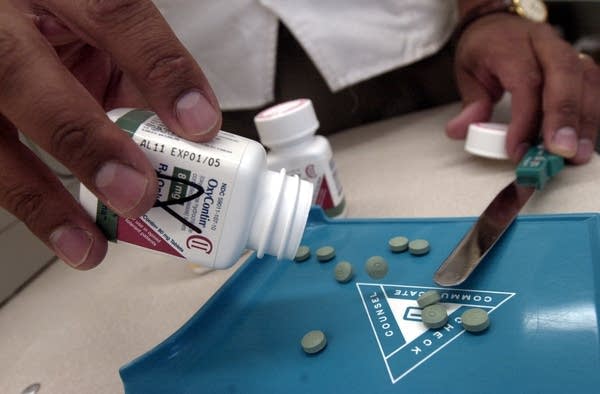Law enforcement fighting 'epidemic' of heroin use
Go Deeper.
Create an account or log in to save stories.
Like this?
Thanks for liking this story! We have added it to a list of your favorite stories.

Concerned about a spike in heroin use around the state, Minnesota's law enforcement and public health agencies are trying to cut off the source of the heroin and at the same time get hold of what has quickly become an epidemic.
In a report to be released today, the state Department of Human Services cites a record number of opiate-related deaths in the Twin Cities alone. Experts point to the fact that Minnesota has some of the strongest, cheapest heroin in the country. Some tests show 93-percent purity levels — about twice the national average.
Last year, 120 people in Hennepin and Ramsey Counties died after using heroin or other opiates, according to the report. That's more than any since the agency started the report back in mid-1970s.
Current statewide numbers are harder to come by, but local officials across Minnesota confirm that at least 50 people have died so far this year, and it's not a problem confined to the two largest counties.
Turn Up Your Support
MPR News helps you turn down the noise and build shared understanding. Turn up your support for this public resource and keep trusted journalism accessible to all.
As high-potency heroin moves into rural areas, people are dying across Minnesota.
"This is one huge situation Minnesota is facing," said Jerry Edblad, a lieutenant with the St. Cloud Police Department. "We want people to know this stuff is dangerous. It's out there; you may even call it an epidemic."

In the first three months of this year drug and violent crime taskforces around the state seized close to 700 grams of heroin. Last year, they seized over 4,000 grams, but much of it came from one large bust.
Edblad said the heroin is coming from Mexico into the Twin Cities. Dealers are distributing it throughout the state.
"We're pretty confident that they've been instructed — those that are selling it — not to do any cutting with it, meaning mix other chemicals in and try and get a bigger bang for the amount," he said. "That is probably because they are creating a user base in this region of high-potency, very inexpensive heroin. And once they have that user base set up, of course they'll cut it down, double their profits and raise the price."
An opiate-based drug, heroin has a chemical composition similar to morphine, OxyContin, Vicodin and other prescription pain-killers. A change in the chemical make-up for many of those prescription pain killers may be responsible for the rapid increase in heroin use.
David Ferguson, a professor of medicinal chemistry at the University of Minnesota, said drug companies recently modified formulas making it difficult for users to get a high off opiate-based pain killers.
"They haven't changed the actual composition of the drug that induces the analgesia, or the pain relief, or you could say to the user, the high," Ferguson said. "They've modified the rate at which it's released from the pill and it's made it complex for users to crush the tablets and to extract the component, the morphine like substance that gives them the high."
Law enforcement officials suspect that after the drug companies made it harder to get high off prescription drugs, many addicts turned to heroin for a cheap, easy high.

That's exactly what a drug user named Sam said motivated his decision to switch from prescription drugs to heroin. MPR News is not using the man's last name because he worries about the stigma attached to heroin addiction.
"I was doing OxyContin and somebody just said to me, 'Why don't you just do this, why don't you just do heroin,' " he said.
Sam grew up in a Twin Cities suburb, played sports, and earned mostly A's and B's in high school. Like a lot of teenagers he also experimented with drugs — first marijuana, then mushrooms and prescription drugs. He first tried heroin when he was 14 or 15.
"As soon as it just rushed over me, I remember thinking ... I couldn't breathe," he said. "And all of the sudden it just let out with a breath and it was just total, couldn't move, just relaxed."
Stories like Sam's are increasingly common. In 2000, less than five percent of those entering treatment programs in the Twin Cities sought help kicking additions to heroin, pain killers and other opiates. But in the last decade the portion of addicts seeking that kind of help climbed to over 20percent, according to the Minnesota Department of Human Services.
"The thing with heroin is I can look at it now and know how dirty it is and where it brings you."
Dr. Joseph Lee, medical director for youth at Hazelden, a national treatment center based in Minnesota, said there is certainly a place in medicine for opiate-based pain killers. But Lee said there is also a direct connection between prescription drug abuse and heroin.
"A typical story I might see is a young athlete who has an ankle injury or knee surgery and they have an unusual reaction to the pain medications that are prescribed appropriately," Lee said. "And they start to crave more of it, abuse it, or take more."
Lee said pain-killers have a way of making those who are pre-disposed to addiction feel warm, complete.
"When that addiction gets deep enough and heavy enough and expensive enough that's when heroin enters the picture ... Heroin is a fall-out of the prescription drug epidemic and those are the stories you see," he said. "They didn't start out 16 years-old jumping into heroin and got hooked."
Law enforcement and public health officials acknowledge they have a difficult task ahead of them in addressing a growing heroin problem -- especially in a state with little precedence for it.
For decades heroin just wasn't widely available in the state, said Carol Falkowski, drug abuse strategy officer at the Minnesota Department of Human Services. Falkowski, who authored the report released today, has spent 26 years following drug trends in the Twin Cities and comparing that data to what's happening around the country.
"Now heroin is the big story here," she said. "We find ourselves at an enormous learning curve in this state about how to address opiates." Besides those efforts, law enforcement officials are becoming more aggressive in the fight against heroin.
In Mille Lacs County, about an hour north of the Twin Cities, there have been four heroin related deaths since January. In one death, police officers learned who sold the victim heroin and filed third-degree murder charges against several individuals, County Attorney Jan Jude said.
"I can't remember a heroin case before this last year," Jude said. "It's possible there may have been one or two, but it's just not something we saw. Now we see it all the time."
Sam has stayed away from heroin. Now a 21-year-old college student who has a job in the Twin Cities metro area, he had to seek treatment three times before getting clean. He knows every day is a challenge.
"The thing with heroin is I can look at it now and know how dirty it is and where it brings you," he said. "I've been to the bottom I've had friends die from overdoses. I've seen people that are just living in misery because of it. But I totally understand why. It is truly something else by itself. I've never done anything that has come close to that and it, it's powerful."





